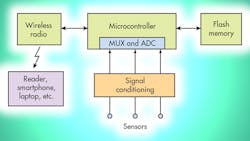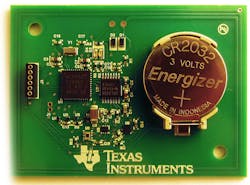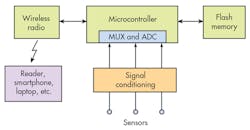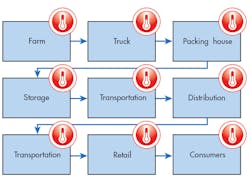This file type includes high-resolution graphics and schematics when applicable.
Data-logging equipment for monitoring and recording events isn’t new. In fact, various forms of it date back decades ago. The earliest data-logging process involved manually recorded sensor readings that were then plotted on graph paper. Strip-chart recorders arrived next; they plotted sensor readings with ink on printed charts. Today, virtually all data logging is electronic.
Innovative electronic developments over the years have significantly advanced data-logging techniques. Now, products targeting the growing Internet of Things (IoT) movement are finding their way into next-generation data-logging equipment. Actually, you could define data logging as one segment of the huge industrial IoT market. Here’s a review of data-logging fundamentals and some examples of new devices being adopted into the IoT fold.
Data-Logging Basics
Data logging is the process of monitoring various physical conditions and recording them over an extended period of time. The collected data is accessed and then observed and analyzed at a l ater date. Data logging is not to be confused with data acquisition. While data logging is a type of data acquisition, it uses a lower sampling rate (seconds, minutes, hours, or even days). Data-acquisition systems sample data at high speeds (kS/s, MS/s, GS/s) for real-time monitoring and analysis as well as recording.
Some of the typically monitored physical characteristics include:
• Temperature (the most common)
• Humidity
• Pressure
• Liquid flow or level
• Mechanical position
• Strain
• Load
• Vibration
• Light level
• Current, voltage, or power
• Event occurrence
• Wind speed
• Time of use
• Others
Thousands of different sensor types are available for monitoring virtually any physical characteristic. Many newer sensors incorporate an analog-to-digital converter (ADC) to provide a digital output.
Data loggers come in multiple forms, but generally break down into four basic types:
• Standalone: These are usually small, battery-powered devices that may use a single sensor or multiple sensors. The sensors are signal conditioned, sampled, and multiplexed and sent to an analog-to-digital converter (ADC), and then stored in flash memory. An embedded microcontroller with appropriate software automatically controls the whole process. Data is later collected typically by a USB port and transferred to a PC for display, analysis, or more permanent storage. Battery life is very long, ranging from months to years.
• PC-based: In a PC-based system, the sensors feed a data-logging module connected directly to the PC. Software on the PC controls the operation. What makes a PC system desirable is extra software that can provide real-time display and visualization as the sensors update, offering instantaneous data analysis, massive data storage capability, and a communications link to a network as needed.
• Web-based: A web-based system can be either standalone or PC-controlled. It’s connected to the Internet via some wired or wireless network. Data is transmitted to a remote secure server, where it’s stored and can be accessed later for further processing.
• Wireless: A wireless data logger uses some wireless technology to transmit the data to a site where it’s collected and used as required by the application. Most wireless data loggers are of the standalone variety. A wide range of wireless options are available, including Wi-Fi, Bluetooth, ZigBee, ISM band, NFC, cellular (M2M), and others. Figure 1 shows a typical data-logger configuration.
Data-Logging Applications
Data logging is more common than you think. Listed are some examples that illustrate its usage:
• The On-Board Diagnostics (ODB) port on most cars and trucks can utilize a data logger not only for trouble diagnosis, but also to monitor key vehicle performance factors. A small data logger can be plugged into the ODB port connecter under the dash near the steering wheel to capture vehicle usage, speed, stops and starts, location, braking, acceleration, and other driving factors. Insurance companies use ODB data loggers to determine rates on volunteer users.
• Weather stations are important data loggers. The U.S. Weather Service as well as state and local governments support many sophisticated weather stations that collect data for the record and for prediction purposes.
• Environmental monitoring is another similar application. Such data loggers identify pollutant levels, allergens, and related factors for regulatory compliance and consumer reporting.
• Airplane black boxes (really orange) called flight data recorders are rugged and sophisticated data loggers. They are essential in determining causes of crashes and diagnosing other airline problems.
• Medical data loggers are used in hospitals to collect patient data over time for later analysis. Portable, battery-operated data loggers are used on patients to monitor key physical characteristics in patients as they go about their lives.
• Automotive testing is another common use of data loggers. Multiple factors are monitored and recorded as a vehicle is put through necessary tests for performance or environmental conditions.
• Process monitoring is a useful application in factories and plants to record machine or system usage for maintenance and troubleshooting actions.
• Road-monitoring data loggers collect data on traffic conditions such as number of cars passing, speed, road conditions (wet, icy, etc.), and traffic clogs.
• Agriculture monitoring allows farmers to continuously collect data on temperature, soil moisture, humidity, and other key factors to improve crop yield, survival, and quality.
• Cold-chain monitoring is another interesting and useful data-logging use. Cold-chain management is a form of asset tracking that helps ensure a product temperature remains at a desired or lower temperature to avoid spoilage. Such data loggers are important in particular for food and medicine, and in many industries like food stores, hospitals, pharmaceutical manufacturing, transportation and warehousing (Fig. 2). Consider fruits or vegetables as they are collected in the field. Their temperature should not be too high to spoil them. Temperature can be monitored as they are transported multiple times, processed, and stored to avoid spoilage. As for pharmaceuticals, temperature monitoring is critical, but humidity and light exposure may also be factors in maintaining quality.
IoT Products for Data-Logger Designs
IoT products like sensors, microcontrollers, and wireless integrated circuits are ideal for creating more effective data loggers. After all, most data logging is another form of the larger IoT monitor, record, and control process. IoT products are smaller, less expensive, consume less power, and possess increased computing power. This is exemplified in the multiple new wireless chips and modules now available, most of which implement Wi-Fi, Bluetooth, or ZigBee networks. However, other wireless standards like near-field communication (NFC) are in the mix, too.
Sensors are the inputs for data loggers and other IoT applications—the better the sensor, the higher the quality of measurement. Precise and accurate sensors are usually larger and more expensive, but new smaller, cheaper semiconductor sensors are arriving onto the marketplace.
Consider temperature sensors. To achieve the desired accuracy, designers usually opt for analog sensors such as RTDs, thermistors, or thermocouples. RTDs and thermocouples are expensive, but may be needed to achieve the desired accuracy for the application. Furthermore, these sensors require special signal-conditioning circuits. Of course, on top of that, you’ll need an ADC and a multiplexer with multiple sensors.
Some analog temperature semiconductor sensors have been available for years. However, they don’t provide the accuracy needed by some applications, and still require signal conditioning. Today, a variety of new digital sensors with on-board signal conditioning plus an ADC are on the market. This goes for temperature sensors as well as sensors for humidity, light level, flow, pressure, and others. These newer sensors consume very low power and typically have an I2C or other serial interface to facilitate connection to a microcontroller. Such sensors can improve data loggers’ accuracy and make them less expensive.
Key Components
Dozens of microcontroller options are available for loggers. For most designs, 16-bit devices are adequate, but today multiple 32-bit processors can be had for reasonable prices. A key requirement is very low power consumption and I/O. The processor should offer initial minimum power usage, and it’s desirable to have multiple sleep modes. On-board timers are also useful programming aids. A real-time clock for time and date-stamping of collected data is an asset as well.
Do not forget the memory! Some non-volatile, low-power flash or ferroelectric FRAM technology for storage is a requirement for most designs.
I/O is another critical factor, such as serial-interface choices to match to the sensors and other peripherals. I2C is popular, but older RS-232 UART interfaces and others are still used. SPI and USB are other attractive choices. Again, don’t forget the ADC and possibly a multiplexer.
Many standalone data loggers use wireless connectivity. As mentioned, the main choices are Wi-Fi, Bluetooth, ZigBee, ISM band, and NFC. Other options can be implemented for special cases, but those listed cover over 90% of the needs.
Basically, the connectivity choice depends on the environment. Wi-Fi is useful if an access point is nearby. Direct-access Wi-Fi can be used with a laptop or tablet for occasional data downloading. The same goes for Bluetooth, since it makes smartphone access a possibility. ZigBee is an option if a mesh network is implemented. For remote locations, ISM-band wireless (< 1 GHz) can be used. Lower frequencies, such as 902-928 MHz, cover a longer range (many kilometers) than the other wireless possibilities. Cellular is another option; M2M services from major carriers can be employed in situations where distances are long and a cellular network is present.
NFC is an interesting choice for a data logger because of its short range. NFC/RFID tags or transponders compliant with the Type 4 tag platform and ISO/IEC 14443B RF interface specifications are available for some applications like cold-chain monitoring. The processor is set up to read and write NDEF (NFC Data Exchange Format) messages for configuration and control.
This 13.56-MHz wireless technology has a range generally less than a foot, which limits the communication of the tag to a close-proximity reader. Smartphones, tablets and laptops incorporating NFC make convenient readers with suitable app software. It’s also possible to use special readers. Furthermore, the NFC connection can pair with another device that incorporates longer-range Wi-Fi or Bluetooth wireless.
Check out other devices that target IoT applications. And don’t overlook development systems software and reference designs that can ease and shorten the design process.
About the Author

Lou Frenzel
Technical Contributing Editor
Lou Frenzel is a Contributing Technology Editor for Electronic Design Magazine where he writes articles and the blog Communique and other online material on the wireless, networking, and communications sectors. Lou interviews executives and engineers, attends conferences, and researches multiple areas. Lou has been writing in some capacity for ED since 2000.
Lou has 25+ years experience in the electronics industry as an engineer and manager. He has held VP level positions with Heathkit, McGraw Hill, and has 9 years of college teaching experience. Lou holds a bachelor’s degree from the University of Houston and a master’s degree from the University of Maryland. He is author of 28 books on computer and electronic subjects and lives in Bulverde, TX with his wife Joan. His website is www.loufrenzel.com.





